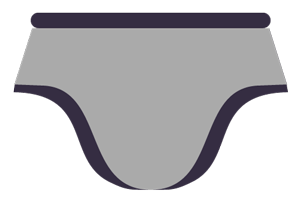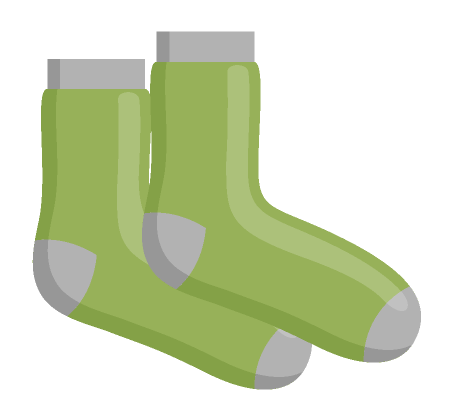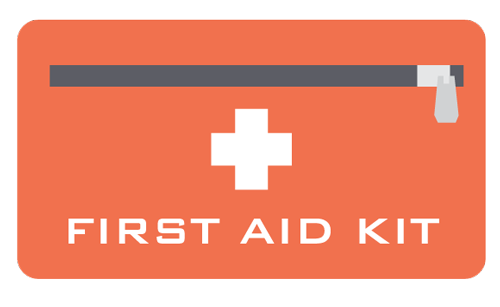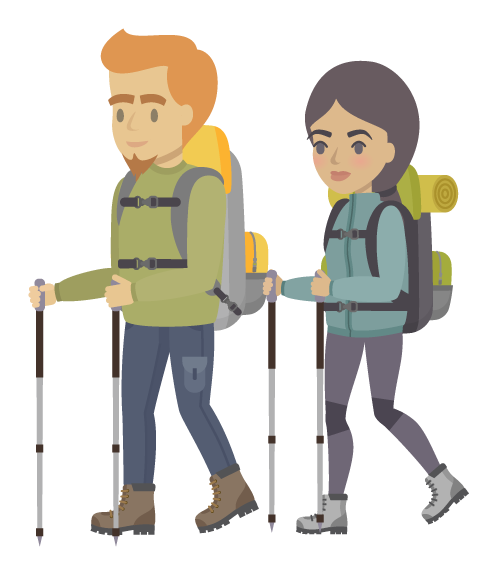The Beginners Guide to Hiking (2020 update)
The challenge beginner hikers face is they don’t know how to start, how to prepare and what to pack for hiking.
In this guide we will help you to prepare for your hiking.
You can read about the gears, accessories to pack and foods you need to take for hiking.
Benefits of Hiking

Cardiovascular health
Hiking helps your heart to stay healthy. It is a good cardiovascular exercise. Hiking make your heart pump more blood to meet the oxygen demand during the hiking.
It is similar to interval training. Interval training is a type of training that involves a series of low- to high-intensity workouts interspersed with rest or relief periods.
You can start the hike in flat terrain, then hike uphill, then downhill. Take short rest in between.
Fitness and weight loss
Regular hiking can help you in weight loss. A study conducted by American Council for Sports Medicine shows that you will burn up to 600 calories per hour while hiking. This can increase or decrease with the weight of person and the difficulty of terrain. Hiking uphill and carrying a heavy backpack can burn more calories.
Stress and focus
Hiking can reduce your stress. A recent study published in The Proceedings of the National Academy of Science found that exposure to nature can counter act the effects of stress.
While you were hiking you will have complete focus on the activity which helps to relieve stress.
Cleanse your lungs
Hiking are done away from population and you will be surrounded by fresh clean air. This helps to cleanse your lungs.
Plan Where to Hike
The first step will be to find a place to hike. You must choose one that suit your fitness level and can be completed without much difficulty.
It’s an interesting thing to plan your hiking trip. Whatever you plan, be flexible as you are outdoors in the mother nature; everything won't go as planned.
Expert hikers know these. So, keep this in mind while planning and preparing your hiking.
As you are a beginner you must understand your limits. We will discuss the factors that you have to keep in mind while planning a hike.
Your fitness level is an important factor while choosing the nature and type of hikes.

Access your fitness level by asking you a few questions.
This will give you some idea on you fitness level and can help you to choose a hike that is for you.
How many miles in a day?
Most people who are not familiar with hiking may struggle to complete 8-12 miles in a day, on flat terrains.
However in the outdoors, you have to cross the mountains, hike uphill and downhill. In such scenarios start with shorter distance. As a rule of thumb, you can cut one mile for every 1000 ft. of elevation.
If you start in the morning you can cover some 8 -12 miles in a day. With easy or difficulty. This depends on your health condition and terrain.
In normal course you can complete 3 miles in an hour on a flat terrain. Considering elevation, you can add 30 mins for every 1000 ft. of elevation. That way you can estimate the time for finishing a hike.
Find a hiking trail anywhere on the world
Use google maps to find a place to hike. You can search your nearby or distant places that you want to hike. Zoom into places to locate green areas. Usually national parks or forest areas are marked green in google maps.
You can now search that area to find images and reviews given by hikers.
The next thing is to fix your destination.
You need to have a fixed point to reach to have the motivation to complete your hiking.
So, search the area to find some interesting place to hike. It can be waterfall or hill top. I am a fan of hill top and love the majestic views from top.
It gives me great motivation to hike to meadows. So, find a destination that motivates you.
Find trails leading to the location.
Find trails that leads you to the location. Find one trail that matches your physical abilities by considering the points that we discussed above. You can use alltrail.com to find trails easily.
Understanding the terrain
Use the terrain view on google maps or the physical topographic map of the area. You can find out how difficult or ease the hiking will be.
Understanding the terrain is very important. As the trail may be 10-mile root on the map. It will be ease if it is flat with 100ft of total elevation. But the hike will become difficult if it has 3000 ft elevation gain and loss (You climb the hill and return to base through same route). Ten-mile hike on an elevation is difficult and slower than on flat terrain. So, you must choose the trail length by understanding the terrain.
“Hiking up a steep grade will slow you way down, forcing your muscles to work much harder. Hiking a downgrade will be easier on muscles but much harder on joints. “
Check for permits
You must take entry pass or permits to enter national parks or a trail. But some may be free of charge. It will be good to check with the authority in charge about the permits and other fees. This also helps you to avoid entry to restricted places in a national park. It’s illegal to hike in a restricted area, and can put you in trouble.
Trail condition
Check the trail condition before you finalize the trek. You can get this information from the bloggers or from the park authorities. The dusty trail in summer season can be a muddy mess in rainy season.Look for any water crossings; if the water level is high it will become difficult for you to cross the stream without a bridge. On higher elevation the trail can be snowy. So, get the information from authorities or from local bloggers.
Prepare for Hiking
So, you have selected a place to hike and choose a suitable trail and gathered the required information on permits and trail condition. Let's prepare for your hiking.
While preparation you will gather the necessary information about
- Hiking trail
- Decide whether you hike solo or with a group

Understanding the Trail
Gather more information about the hiking trail.
Do a google search about trail.
Use this formula “trail name”+ blogs, the search will bring enough blog articles about the trail.
You will get a clear idea about the terrain, wildlife, and other information that are otherwise difficult to find. They may give you some insider secrets also.
Find a Group or Club to Hike With
Being a beginner, it is good to hike with a group. You can learn outdoor skills when you are in a group (Like map reading and using compass). They will be happy to share their knowledge with you.
They can identify the trail route and thus reducing the chance of getting lost in the wild. During group hiking the chance of spotting an animal will be less (due to noise). So, if you love to see wild animals, then select a small group and try to be quiet while hiking.
Solo Hike
I don't recommend solo hiking if you are a beginner. But if you like to hike alone, then try some familiar parks near to your home or Hike during peak season as there will be more people on the same trail. There will be someone to help you in case of emergency. Hiking solo increases your chance of spotting wild animals.
There is also risk of animal as well as human attack.
In solo hiking you must take the responsibility to find routes. This will increase your skills in the outdoors. At the same time as a beginner your skills with map reading and trail finding are poor, there is chance to get lost in the wilderness.
Weather
Check the weather and make sure that you are comfortable with the forecast. it's not possible to predict the weather correctly.
A clear sunny day can soon change to a heavy downpour with lightning clouds. That often happens on the trail. It’s nature, you can't always predict what will happen in the outdoors.
So be prepared to face anything.
Make sure that the weather is fine; If not, postpone the hike. This may feel bad, but getting out in rain under lightning clouds; on the top of a mountain is not a good idea.Leave a Trip Plan with a Trusted Friend or Relative
Inform friend/relative about your hiking. You can send them a copy of your itinerary and schedule. If you were lost in the hike your friend can inform the authorities for help and rescue.
Hiking skills
Basic survival skills

Learn How to Read a Topographic Map
This will be a most demanding skill if you hike solo.
You can find out your location with the help of topographic map and compass. In a topographic map the changes in earth's surface are shown as contour lines. The mountains and valleys will be shown using contour lines. You can find out the elevation of mountain or how steep the mountain side is.
For one day hike; a GPS or even your smartphone map will be enough. Download offline maps; as there may not be network coverage. GPS will drain your mobile battery faster. Try to keep a power bank to charge your phone.
For multi day hikes keep a topographic map and compass with you.
What to Wear
Wearing the right clothing makes you feel comfortable while hiking. A wrong choice or wrong size clothing can make your hiking a miserable experience.
Choose the clothing according to the weather and temperature of the trail.
As a beginner you don't need to buy all the stuff discussed here. Use what you have or borrow from your friend.
You can use your old t shirt. Make sure you layer, if it’s cold.
Take raincoat in your backpack. Rain coat can work as an extra layer of insulation.

Check price on amazon
Shirt and T-Shirt
For hiking you can wear performance t shirts available for running. You will be naturally inclined to wear cotton shirts for hiking. But don't use them in hiking. As cotton shirts will soak up with your sweat and trap the moisture. This make them less breathable and makes you feel hot. Cotton is worse in both cold and hot climate. If the outside temp drops then wet cotton will chill you down.
You can choose a light merino wool shirt or t shirt or any synthetic fabric. Merino wool and synthetic fabric (nylon and polyester) are breathable wicking the moisture and pass the air out.
Check price on amazon
Pants and Shorts
Pants or shorts is again your choice. If the weather is hot, you can wear shorts. Shorts give you the most range of motion and comfort in hot weather. But when it’s cold you can choose pants over shorts. Pants are also useful while you hike through thick vegetation. Thus, protecting your legs from bushes and allergic plants like poison ivy.
The pants like Columbia Silver Ridge Pants are convertible as you can convert them into shorts by using the zip. Remove zippered leg, then keep them in your backpack.

Jacket
A jacket will be the outer layer of your layering. This will keep you warm in cold weather. Look for one that is lightweight, breathable and waterproof.

Rain jacket
Always pack your rain jacket in your backpack. Don't rely on the weather forecast while packing. Weather can change anytime in the mountains. So be prepared for the extreme. So always keep a rain jacket in your backpack. Look for jackets that is lightweight, packable and breathable. Good breathable jackets help to move moisture and hot air out.

Underwear
For hiking, don't choose cotton underwear. Cotton will absorb the moisture and cause discomfort. The best choice will be merino wool or nylon and polyester underwear. They wick out moisture and will dry out quickly.
Choose merino or synthetic materials as the first Layer in your layering system. Choose boxers over regular underwear, boxers prevent the rubbing of your thighs. The same also goes while selecting long underwear, sports bra and panties. If it's cold wear Long Underwear bottoms to protect your legs from cold.

Hiking boots and Shoes
It’s your preference to choose either hiking boots or shoes. Hiking boots can provide you with good ankle support particularly useful in rocky (slippery) terrain. They also provide support during uphill climbing thus assist your calf muscles.
While shoes are light in weight and will be enough for a day hike. In a day hike you carry less; so, a shoe will be a good choice. I personally prefer shoes over boots.
Hiking with shoes will make your ankles stronger.
But if you like to hike with boots- no problem. After All it's your comfort. One thing to remember, before a full day hike remember to break in your boots before you take it for a day hike.
Use the boots for small walks in nearby park. Always buy the correct size boots or shoes, loose size or tight can cause blisters and discomfort.

Sandals
Some prefer sandals over boots and shoes. Sandals are light weight than shoes. There will be airflow over your feet thus adding comfort.
Crossing streams will not be a problem, sandals will dry out faster. But they do have some disadvantages. Your feet will be prone to injury from sharp rocks and twigs.
Sandals lacks ankle support and thus they are prone to injury. Your feet will be exposed and thus increasing the chance of snake bite.

Socks
In terms of socks choose wool, or synthetic over cotton socks. Cotton socks will slide around and can cause blisters. Cotton socks absorb your sweat and gets wet thus causing discomfort.
Wool absorbs sweat and dry off quickly. It doesn't stink like cotton socks.

Hats
Hats are useful to protect your face and head. You can use wide brimmed hat or baseball hat while you are in the outdoors.

Sunglasses
Sunglasses will take care of your eyes. Look for UV protection glasses.
UV buff
Use UV buff if you are hiking in the snow. It will help to protect your neck from reflected UV rays from snow. The same will work in dusty trails by shielding your neck from dust.
Day Hiking Backpacking
You must carry the essentials in a backpack.
The packing items depends on the number of days you hike, weather, terrain, and some personal preference.
Here you can read about a beginner packing tips for day hiking.
Day hikes gives you the opportunity to familiarize hiking with backpacks.
So, you can easily carry out multi day hikes.

Carry a comfortable backpack
You don't need to invest in a new hiking backpack. You can use a backpack that you already have.
For your day hike you will not need to pack lot of items. You need to pack the hiking essentials and your jacket on your backpack.
The items for a day hike will fit in a normal backpack. If your backpack has a hip belt, then it’s perfect for hiking. Hip belt will transfer the load from shoulder to hips.

Pack light
You are going to carry the backpack for 8-12 miles. The weight of backpack is very important. Try to pack light. But make sure that you have packed the essentials.
The Ten Hiking Essentials
The ten essentials list was first compiled in 1930 by The Mountaineers -a Seattle based mountaineering group to help people prepared for emergency.
The group updated the list in 2003 grouped similar items into systems.


Navigation (map and compass)
Your first option will be the map on your mobile phone. You can use them to navigate. The mobile phone GPS may not work at all the times, if there is poor signal strength. So as a backup; pack a map and compass with you.
But there is a problem:
To use map and compass you must learn map reading. As a beginner this is an important skill in outdoors. A topographic map and a compass can be a lifesaver if you found lost in the wild.

Sun protection (sunglasses and sunscreen)
Choose a sun glass that block ultraviolet rays of sun. if you are hiking in mountains on snow or glacier choose extra dark glacier glasses.
Similarly choose a sunscreen that has a sun protection factor from 15 - 30+.
You will sweat a lot while hiking. Buy a sunscreen that is waterproof, as it avoid the need to reapply too often. Apply sunscreen on your hands, face and neck.

Insulation (extra clothing)
In the outdoors weather is unpredictable. A sunny day can change suddenly to a heavy downpour. Pack some extra clothes to add to your layering to fight cold. You can take a synthetic jacket, extra socks and underwear in your insulation pack.

Illumination (headlamp/flashlight)
Your planning may not work well all the time. You may have to hike in the dark to reach the destination. Use headlamps or flashlights, while headlamps give the advantage of hands free operation.

First-aid supplies
Be prepared for an emergency, you must carry fit aid kit in your backpack. But it doesn't mean you have to buy all items. You can buy a prepackaged first aid kit like this from REI.com. These have all the essentials.
As you get some experience with outdoor, you can customize the first aid kit according to your needs. Always keep your first aid kit waterproof by keeping it in sealed covers.
Fire (waterproof matches/lighter/candles)
Not an essential for a day hiker, but doesn't take much space in your backpack. You can take water proof matches or a mechanical lighter and keep them in a waterproof plastic cover.

Repair kit and tools
Take a multi tool or pocket knife, you can use it to cut bandages or to repair your gear. Wrap strips of duct tape around your water bottle, don't know about uses of duct tapes in outdoor? Read this article on duct tapes.

Nutrition (extra food)
You must pack some extra food, worth an extra day. The options include protein bars, energy bars, nuts, etc...

Hydration (extra water)
Take one water bottle and a collapsible water reservoir. If possible, take a water filter or chemical purifiers. Alternatively, you can choose a water filter bottle, which servers the purpose as a water filter and water bottle. Thus, saving space. Try to fill water when you spot a clean water source.

Emergency shelter
Emergency shelter is meant for day hikers. As overnight hikers will carry their tents and sleeping pads. If you are lost or must stay in the forest due to injury; you can use the emergency shelter.
It can range from a lightweight tarp, bivy sacks or emergency space blanket. The space blanket is lightweight and packable, it will not take much space in your backpack. They are waterproof and windproof, gives good insulation in cold climate.
Even a plastic trash bag can be used as an emergency shelter.

Whistle and mirror
This is a bonus item, you can use them to call for help in case of an emergency.

Camera
If you have one, pack it in your backpack. Take pictures and add it to your album.
What to eat?
We have talked about nutrition in the top ten essentials.
You must take enough food to make the hike energitic.
Hunger will spoil the fun.
While hiking you need to take calorie dense foods.


Nuts
Nuts fulfill the above criteria. They are light and are calorie dense and have lot of options. A handful almonds or peanuts supply good calorie.

Fruits
Fruits are nutritious and contain water, an essential item on your hiking. One or two banana and apple will be enough.

Dry fruits
They are healthy alternatives to fresh fruits. Dried fruits packs light and provide vitamins and minerals. You must drink water while eating dried fruits. As water is needed for digesting them. Dry the fruits yourself, this way you get the healthy dry fruits free of sugar and preservatives.

Chocolate and energy bars
Chocolates and energy bars are high in calorie and packs light. They will give you quick energy boost.

Granola bars / trail mix
They are good options as trail food. They are loaded with calorie due to sugar. Calorie is essential while hiking. But at the same time the sugars and salts are unhealthy. If you want healthy alternative; you can make and bring your own granola bars while you hike. If you were buying those bars look for ones with less refined sugar and more cereals.
Hiking Safety & Tips
As a beginner you can develop your hiking and safety skill.
You can read or learn from the other experienced hikers in your group.
As a safety measure leave a copy of your trail itinerary with your friend or with someone in your family.
So that they can call the authorities in an emergency.

Trail safety in Hot Weather
Take more water with you. In hot weather dehydration, heat stroke or even death can happen to you. So, learn about the warning signs of dehydration or heat stroke. Drink enough water and protect yourself using hat and applying sunscreen.

In the Rain
Don't forget to take your rain jacket in your backpack. Hiking in the rain is not a good thing, especially in cold climate. There is a chance of hypothermia if the temp is lower.

At Night
It is difficult and scary for a beginner to hike solo at night. Choose a trail that you can comfortably finish before sunset. While being in a group, night hiking will not be a problem.

Water crossings
While you hike you may come across a stream or river. You must listen to the instructions of group leader. If you are hiking solo then look for any alternative ways to cross, like a nearby bridge or shallow area where you can cross.
Be careful while crossing as water level can rise quickly if there is rain in the forest.
First aid kit
It is a part of your 10 hiking essentials. Don't forget to pack it while you hike. While hiking in a group you will get help from your team members in first aid. Learn from them, will be useful on your solo hike.
Trail Etiquette
Keep your voice down while hiking and enjoy the sound of nature.
You have a better chance of spotting wild animals if you keep the noise level low.

Leave no trace: You must take back whatever you bring with you.
“You must take only pictures and leave only footprints” . Don’t leave food wrappers and other bio waste on the trail. It's harmful to wild animals and affect the ecosystem. Aim to cause minimum impact on the surroundings.
Toilet: Look for a place 200 ft away from the trail and make sure there is no stream nearby. Dig a pit and bury the solid waste. Don't forget to bury as it can pollute water downstream during rain.
Try to stay on the trail. Creating shortcuts can harm plants and can cause soil erosion.
Take the picture of the flowers, rocks and anything you find on the route. But don't pick flowers or change anything. Keep it like you have first seen it. Not take anything from the nature as mementos of your adventure.
Be friendly with fellow hikers, say hello to other hikers you see on the trail.
Don't block others: When you are tired or may want to stop for rest; move off the trail and find some place to rest. So that you don't block others way.
Understand the trail guidelines. You can read them at the tailgate. Follow the guidelines.
Common Mistakes Beginners Make
As you are a beginner in hiking, you may make mistakes. We have compiled six beginner hiking mistakes.

1
Inappropriate Clothing
Inappropriate clothing can make your hiking a worst experience. You may tend to wear your cotton shirt. The problem with cotton is that, it will absorb your sweat and gets wet. In cold weather you get chill faster. Avoid using cotton and denim jeans.
2
Not Packing Enough / Packing Too Much
You may pack unnecessary items, which will not be a problem till you start the hike. When you start your hike, the load will be heavy on your shoulders and can make you tired.
But:
Not packing enough will leave you helpless in emergency. So, plan about your packing and remember the ten essentials in packing.
3
Wearing New Boots on Your First Hike
So, you bought new boots for your hike. You are excited to wear it. During the hike the boots will rub against your skin and will cause blisters and discomfort. Before using a boot for hiking you must break in the boot. Use the boots indoors and use it for short walks for 1-2 weeks.
4
Overestimating Your Ability
The beginner tends to overestimate the ability to hike. The terrain will be difficult for beginners. So, understand your fitness level and plan a route based on it.
5
Not Checking the Weather Forecast
Check the weather forecast while planning your trek. This helps you to pack your backpack according to weather.
6
Not Eating & Drinking Enough
The enthusiasm while hike and joy will make you forget to properly hydrate yourself. Always drink before you feel thirsty. You will be losing more water while hiking. Try to drink 1 liter every 2 hours.
Like drinking, don’t skip your food. At Least have the energy bars that can boost your energy levels.
Tips and Tricks

1
Pace yourself
You will start the hike with full energy and will likely to move in faster pace. But soon you will lose your energy, particularly while you are hiking uphill. So, move on a pace that won't wake you tired. Try this- pace so that, you can talk comfortably while you walk. This way you can make sure that you will have the energy to finish the trek.
2
Keep an eye on your surroundings
Observe your surroundings. It has two benefits. It will save you from injuries and to keep safe distance from wild animals. Further, you can enjoy the beauty of the nature.
3
Study your map
As I said earlier; you must familiarize with the trek route. You can do this by reading about the trail from bloggers. Study the terrain using maps. Look for any water source, uphill, elevation, steep and other trail features like emergency exit points.
4
Clean up
After hiking you must take a shower using hot water and soap if you get contacted with any poisonous plant. Also look for any ticks in your body, after hiking in a heavily wooded area.
5
Keep track of your hike
You can use mobile apps to track your hiking. You can track the elevation and the distance you covered.
6
Visit local parks and do short hikes
Visit the local parks near to your home and do short walks. This will help you to prepare yourself for a full day hiking in mountains. Use this as an opportunity to test your new gears like boots and backpacks. You will also develop strength and develop better understanding about outdoors.
7
Aim high ground
Hike to the top of a mountain and enjoy the view from there. I always love to hike to top of mountain more than waterfalls.
8
Gear - Hiking poles
Hiking poles are not necessary, but they are helpful while day hiking or multi day hiking. Hiking poles share the weight of your backpack and reduce the stress on your knees and foot. It can help you in hiking uphill and downhill. Use two hiking poles to get the desired momentum while hiking.
Resources and Reading



